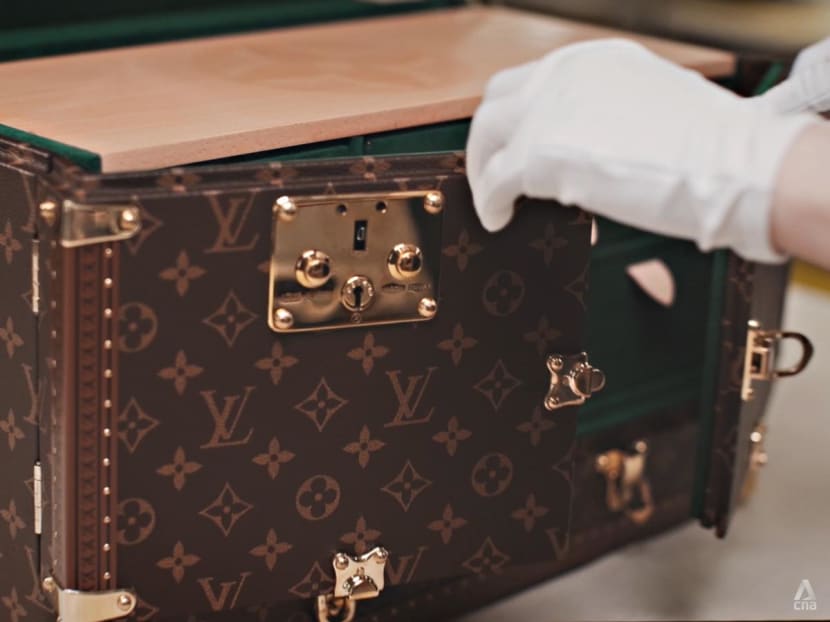Unlocking the secrets of the iconic Louis Vuitton trunk in Asnieres, France, the historic home of the Vuitton family
The making of an icon: The Louis Vuitton trunk.

Over 330 artisans work at the Louis Vuitton atelier at Asnieres where they employ traditional hand-crafted methods, to meticulously produce hard-sided luggage, leather goods, and bespoke special orders that can take several months or even years to craft. (Photo: Freestate Productions)

This audio is AI-generated.
From mahjong sets to prized sneaker collections and even a jukebox, an iconic Louis Vuitton trunk can hold just about anything imaginable.
This emblem of the French maison can be traced right to the beginning when a young French carpenter from the town of Anchay, Jura named Louis Vuitton became a trunk apprentice. After spending 17 years to master the skill, he founded his own company and atelier in 1859, hence laying the foundation for the iconic luxury brand.
His unparalleled talent led him to become the personal trunk maker for the Empress of France, creating carriers specifically designed to transport her opulent and delicate outfits, thus creating the concept of the bespoke trunk.
“No dream is too large or object too complex,” Louis Vuitton once said.


Besides his artistry in building exquisite trunks, he also innovated by replacing the traditional curved lids to create stackable waterproof versions, hence increasing their functionality for travel.
The 1850s ushered in the golden age of exploration, providing Vuitton with the perfect opportunity to revolutionise luxury luggage. His visionary use of three types of wood ̶ okoume, beech, and poplar ̶ resulted in trunks that are lightweight and resistant to humidity, withstanding the rigours of travel.
He went on to build trunks for Maharajas, film stars, explorers, and couturiers, cementing the brand’s status as the epitome of elegance in travel. For instance, he made a luggage for French fashion designer Paul Poiret and created a custom trunk bed for the French explorer Pierre Savorgnan De Brazza.


Today, the tradition lives on at the Louis Vuitton atelier in the Parisian suburb of Asnieres. This town holds a special place in the heart of the storied maison as it was both the birthplace of the brand and the historic home of the Vuitton family. Its strategic location near the River Seine made it ideal for the delivery of the raw materials and wood essential for crafting the iconic trunks.
The Vuitton family residence, an exquisite Art Nouveau gem with stained-glass windows and patterned wall decorations, remains lovingly preserved as a testament to the brand’s dedication to artistry and craftsmanship. Though the family moved out in 1964, the space continues to be used for private events and special occasions.
Over 330 artisans work at the Asnieres atelier where they employ traditional hand-crafted methods, to meticulously produce hard-sided luggage, leather goods, and the piece de resistance ̶ bespoke special orders that can take several months or even years to craft.


Madeleine, a Louis Vuitton craftsman who has been with the maison for five years, started as an apprentice and has since mastered every stage of the trunk making process. “Asnieres has a very special atmosphere. When we arrive in the morning, it is always a source of pride to be part of this big family and to have been trained by the elders, to continue to train others in this magnificent location and to make exceptional products,” she said.
Another leatherworker Florence made a career switch from being a secretary-accountant after she completed a vocational training course in leatherwork for nine months. “I was lucky enough to join Louis Vuitton. I started by making boxes for watches and jewellery and now I am in the special orders team,” she said.
Over the years, the workshop has made all sorts of custom order trunks ranging from water colour paints, tea sets, Christmas decorations and even a storage for children’s baby teeth as requested by a client.
Said Florence: “Special orders are very addictive as I think it is really interesting to be able to make someone's wish come true.”

About 170 years later, the various artisanal techniques and innovations used in the making of each Louis Vuitton trunk remain a hallmark of the brand. For example, each trunk has a pick-proof lock that is so secure that even the legendary magician and escape artist Harry Houdini failed to escape from a box secured with a Louis Vuitton Lock.
One of Madeleine’s favourite techniques is the lozinage technique, which she trains other apprentices in. It uses lozine, a composite material unique to Louis Vuitton to give the luggage a watertight seal. Precise pieces are attached to the trunks with about 500 to 1,000 studs, which are hammered by hand.


Even in modern day, the trunks have withstood the test of time and are still widely considered objects of beauty and artistry. Florence observed: “Previously the Vuitton trunks were really made for travelling but they will also fit in living rooms or in a bedroom. Now, they are made for decorating or for highlighting certain objects.”
Globetrotters can visit the LV Dream exhibition in Paris to explore the rich history and craftsmanship of Louis Vuitton trunks. This immersive exhibition showcases the brand’s iconic trunks as well as interesting pieces from its creative collaborations with artists and designers from around the world.
For instance, there is Japanese artist Yayoi Kusama’s pumpkin minaudiere as well as a medicine cabinet built in collaboration with British artist Damien Hirst. Movie fans can also look out for the whimsical Alzer suitcase set that was created for director Wes Anderson’s movie The Darjeeling Limited.
Ultimately, both artisans say they feel the greatest sense of pride when they see the trunks on display or when they are being used. Madeleine reflected: “We make products that are quite magnificent ̶ a great beauty which is majestic, complete and complex.”
Adapted from the series Remarkable Living (Season 6). Watch full episodes on CNA, every Sunday at 8.30pm.











